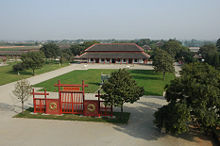Yin Xu
Coordinates:
| Yin Xu* | |
|---|---|
| UNESCO World Heritage Site | |

| |
| State Party | |
| Type | Cultural |
| Criteria | ii, iii, iv, vi |
| Reference | 1114 |
| Region** | Asia-Pacific |
| Inscription history | |
| Inscription | 2006 (30th Session) |
| * Name as inscribed on World Heritage List. ** Region as classified by UNESCO. | |
Yinxu (Chinese: 殷墟; pinyin: Yīnxū; literally "Ruins of Yin") is the ruins of the last capital of China's Shang Dynasty (1766 B.C.E. - 1050 B.C.E.). The capital served 255 years for 12 kings in 8 generations.
Rediscovered in 1899 it is one of the oldest and largest archeaological sites in China and is one of the Historical capitals of China and a UNESCO World Heritage Site. It is located in the central Henan province, near the modern city of Anyang, and is open to the public as the Garden Museum of Yinxu.
It is famous as the original source of oracle bones and oracle bone script, the earliest recorded form of Chinese writing.
History
At the beginning of the 14th century B.C.E. King Pangeng of the Shang Dynasty established his capital on the banks of the Huan River. The city was known as Yin, and from that point on the dynasty that founded it would also be known as the Yin Dynasty.[1]
King Wu Ding continued to use Yin as his capital and from this base launched numerous military campaigns (many led by his own wife Fu Hao) against surrounding tribes securing Shang rule and raising the dynasty to its historical zenith.
Later rulers were pleasure-seekers who took no interest in state affairs as social differences increased within the slave-owning society. King Zhòu (紂), the last of the Shang dynasty kings, is in particular remembered as ruthless and debauched. His increasingly autocratic laws alienated the nobility until King Wu of the Zhōu Dynasty (周) was able to gain the support to rise up and overthrow the Shang.
The Zhōu (周) established their capital in Feng and Hao near modern day Xi'an and Yin was abandoned to fall into ruin. These ruins were mentioned by Sima Qian, in his Records of the Grand Historian, but soon they were lost and their location forgotten with the once-great city of Yin being relegated to legend along with the dynasty that founded it.
Archaeological discoveries
Yinxu is famous for its oracle bones, which were first discovered in 1899 by Wang Yirong, director of the Imperial College.[2]